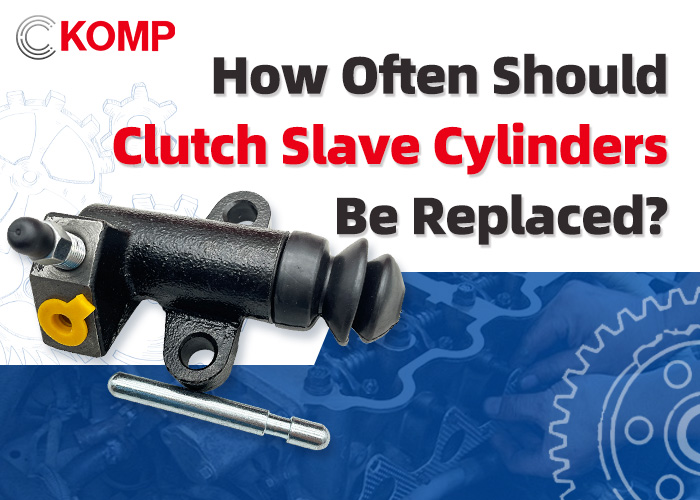Com que frequência os cilindros auxiliares da embreagem devem ser substituídos?
Oct 23, 2025
Com que frequência os cilindros auxiliares da embreagem devem ser substituídos?
Como componente essencial do sistema de embreagem hidráulica, o cilindro auxiliar da embreagem afeta diretamente a segurança na condução e o desempenho da transmissão. Sua confiabilidade determina a suavidade com que a embreagem engata e desengata. Abaixo, apresentamos uma análise detalhada do seu ciclo típico de substituição e recomendações de manutenção de técnicos especializados e fornecedores de cilindros auxiliares de embreagem.
 I. Intervalo básico de expectativa de vida
Ciclo normal: Em condições normais de condução, um
cilindro auxiliar de embreagem de alta qualidade
Geralmente dura entre 2 anos e 60.000 quilômetros. Em alguns veículos bem conservados, pode funcionar eficazmente por até 100.000 quilômetros.
Comparação com o cilindro mestre: O cilindro mestre da embreagem geralmente tem uma vida útil um pouco mais longa, pois o cilindro auxiliar opera em um ambiente mais severo, enfrentando temperaturas mais altas, poeira e vibração da carcaça da transmissão.
II. Principais fatores que afetam a expectativa de vida
Hábitos de condução:
Acionamentos frequentes da embreagem, acelerações bruscas ou partidas difíceis podem acelerar o desgaste. Manter o pé no pedal da embreagem por longos períodos é uma das causas mais comuns de danos nas vedações internas e vazamento hidráulico.
Condições da estrada e carga:
Conduzir em trânsito urbano com paragens e arranques frequentes ou subir estradas íngremes aumenta o esforço do cilindro auxiliar da embreagem. Cargas mais pesadas ou reboques também exigem maior pressão hidráulica, o que pode reduzir a vida útil do cilindro.
Qualidade da manutenção:
Fluido de embreagem de má qualidade ou antigo pode conter impurezas que bloqueiam ou corroem as passagens hidráulicas. O uso de fluidos que não atendem aos padrões do fabricante pode danificar até mesmo um cilindro auxiliar de embreagem de alta qualidade. A substituição periódica de vedações e a inspeção das conexões podem prevenir vazamentos e prolongar a vida útil do componente.
III. Dicas práticas para prolongar a vida
Troque o fluido da embreagem regularmente: Substitua a cada 2 anos ou 40.000 quilômetros para garantir um funcionamento suave.
Inspecione as vedações: Se notar vazamentos de óleo ou pedal macio, inspecione e repare imediatamente.
Adote bons hábitos de direção: evite o uso parcial da embreagem e aplique pressão constante no pedal.
IV. Sinais de Substituição e Aconselhamento Profissional
Sinais que indicam a necessidade de substituição incluem dificuldade na troca de marchas, engate inconsistente da embreagem ou cheiro de queimado durante a condução. Ao realizar a substituição, é recomendável verificar o cilindro mestre da embreagem e o platô de pressão simultaneamente para evitar custos repetidos de mão de obra.
Se você planeja comprar uma peça de reposição, procure um fornecedor confiável.
fornecedor de cilindro auxiliar de embreagem
Garante o controle de qualidade e o ajuste perfeito. Muitas fábricas agora oferecem esse serviço.
cilindro auxiliar da embreagem a preço de atacado
opções, tornando a manutenção mais acessível sem sacrificar o desempenho.
Em resumo, não existe um ciclo de substituição fixo — a vida útil depende dos hábitos de condução, das condições de carga e da manutenção realizada. Inspeções regulares e uma condução responsável são as melhores maneiras de prolongar a vida útil do seu sistema de embreagem.
I. Intervalo básico de expectativa de vida
Ciclo normal: Em condições normais de condução, um
cilindro auxiliar de embreagem de alta qualidade
Geralmente dura entre 2 anos e 60.000 quilômetros. Em alguns veículos bem conservados, pode funcionar eficazmente por até 100.000 quilômetros.
Comparação com o cilindro mestre: O cilindro mestre da embreagem geralmente tem uma vida útil um pouco mais longa, pois o cilindro auxiliar opera em um ambiente mais severo, enfrentando temperaturas mais altas, poeira e vibração da carcaça da transmissão.
II. Principais fatores que afetam a expectativa de vida
Hábitos de condução:
Acionamentos frequentes da embreagem, acelerações bruscas ou partidas difíceis podem acelerar o desgaste. Manter o pé no pedal da embreagem por longos períodos é uma das causas mais comuns de danos nas vedações internas e vazamento hidráulico.
Condições da estrada e carga:
Conduzir em trânsito urbano com paragens e arranques frequentes ou subir estradas íngremes aumenta o esforço do cilindro auxiliar da embreagem. Cargas mais pesadas ou reboques também exigem maior pressão hidráulica, o que pode reduzir a vida útil do cilindro.
Qualidade da manutenção:
Fluido de embreagem de má qualidade ou antigo pode conter impurezas que bloqueiam ou corroem as passagens hidráulicas. O uso de fluidos que não atendem aos padrões do fabricante pode danificar até mesmo um cilindro auxiliar de embreagem de alta qualidade. A substituição periódica de vedações e a inspeção das conexões podem prevenir vazamentos e prolongar a vida útil do componente.
III. Dicas práticas para prolongar a vida
Troque o fluido da embreagem regularmente: Substitua a cada 2 anos ou 40.000 quilômetros para garantir um funcionamento suave.
Inspecione as vedações: Se notar vazamentos de óleo ou pedal macio, inspecione e repare imediatamente.
Adote bons hábitos de direção: evite o uso parcial da embreagem e aplique pressão constante no pedal.
IV. Sinais de Substituição e Aconselhamento Profissional
Sinais que indicam a necessidade de substituição incluem dificuldade na troca de marchas, engate inconsistente da embreagem ou cheiro de queimado durante a condução. Ao realizar a substituição, é recomendável verificar o cilindro mestre da embreagem e o platô de pressão simultaneamente para evitar custos repetidos de mão de obra.
Se você planeja comprar uma peça de reposição, procure um fornecedor confiável.
fornecedor de cilindro auxiliar de embreagem
Garante o controle de qualidade e o ajuste perfeito. Muitas fábricas agora oferecem esse serviço.
cilindro auxiliar da embreagem a preço de atacado
opções, tornando a manutenção mais acessível sem sacrificar o desempenho.
Em resumo, não existe um ciclo de substituição fixo — a vida útil depende dos hábitos de condução, das condições de carga e da manutenção realizada. Inspeções regulares e uma condução responsável são as melhores maneiras de prolongar a vida útil do seu sistema de embreagem.
